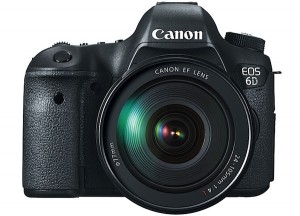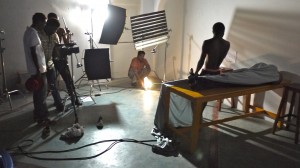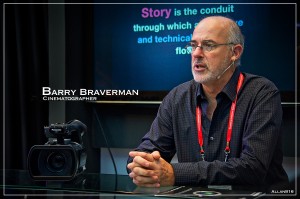Archive for the ‘Craft of the Video Shooter’ Category
 What’s Really Important Is Not the Technical Crap
What’s Really Important Is Not the Technical Crap
Then why the obsession with tech chatter in the many online forums? What is it about tech talk that we find so engaging and enthralling?
In the mid 1980s, the toy company Fisher-Price manufactured a 2-bit monochrome camera that recorded to an ordinary audio cassette. Pixelvision’s cryptic images continue to attract storytellers today, despite, or more accurately due to its obvious lack of technical sophistication. The fact is that stories work for different reasons, and can often be quite successful despite a lousy script, poor lighting, or even I shutter to say, bad camerawork.
Audiences can’t care less if you shoot your story on NXCAM, 35mm Cinemascope, or your iPhone. No one walks out of a movie theatre and says, ‘Gee, that was a great movie but it was shot 4:2:0’. So as you read this blog and perhaps glean something useful from it let’s keep all this tech talk in perspective.
 Who Needs 4K?
Who Needs 4K?
NAB 2013 has come and gone and the prevailing themes this year were clear: cloud-based storage and collaboration and the advent of 4K acquisition. My question is who needs 4K? If you’re shooting a movie destined for the big screen then 4K origination certainly makes sense along with use of the appropriate lenses and a lightly compressed recording format. Short of cinema applications and perhaps broadcast for cutting out multiple HD frames the point of 4K acquisition escapes me.
I expressed this perspective at a recent trade gathering of cinematographers and manufacturers and was roundly booed. My father who bathed extremely infrequently often questioned ‘why clean is better?’ I would like to offer the analogous thought for the vast majority of today’s shooters: Why is more resolution better? Why is 4K desirable?
Please tell me. I’d like to know.
 Motivating the (supposedly) Unmotivated
Motivating the (supposedly) Unmotivated
This week I have been providing basic camera visual storytelling training to staff cameramen at television broadcast facilities in Kuala Lumpur and Singapore. Having offered such training numerous times in the past for the commercial production community I was informed in Southeast Asia that the news cameramen are particularly lazy, unmotivated, and lacking in creative energy.
Nothing could be further from the truth! What I found at the news channels in Malaysia and Singapore were teams of motivated craftsmen eager to express themselves with more cinematic penache. Curiously I discovered the same thing among the producers and writers who also participated in the training. From every quarter there seemed to a pronounced willingness to produce more visually compellling work in the news and current affairs genre. What is missing it seems is a clear mission statement from news directors, station management, and labor unions, that it’s worth the effort for a shooter to try hard and produce outstanding work. It’s not a question of money; it’s really a matter of recognition, that the managers who mete out the shooters’ daily assignments will welcome and appreciate the extra effort and higher standard.
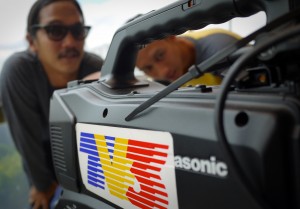
News crews in SE Asia are eager, able, and ready, to provide more compelling visual content, if station managers will simply allow them.
 3D Interest Surging (Again) in SE Asia
3D Interest Surging (Again) in SE Asia
We’ve seem this before in 2010 and now again in 2013: a renewed interest in 3D workshops and training. This week I am finally out of Dhaka and leading back-to-back 3D training sessions in Singapore, at MediaCorps’ educational academy SMA, and at NYU Tisch Asia.
The reason for the surge in interest seems counter-intuitive. The recent success of Life of Pi notwithstanding theatrical 3D has been losing ground and audiences for several years. The anticipated boom in demand however for non-theatrical 3D programming appears to be the big factor this time with the arrival of a 3D iPad and iPhone in late 2013 or 2014. There is an imperative for media training institutions across the region to remain relevant and on the cutting edge as they see it appropriate once again to offer 3D training opportunities for their students.
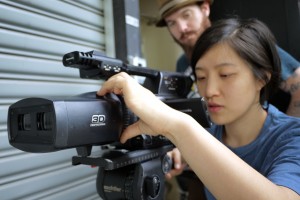
NYU Tisch students practice their 3D skills during a workshop at the university’s Singapore campus 23 Feb 2013.
 The DSLR Wannabes
The DSLR Wannabes
The line between still and moving is rapidly blurring as the latest generation DSLRs become more robust and capable as professional video cameras. The addition of SMPTE timecode in the Canon 6D and Panasonic GH3, in addition to manual audio levels and more extensive control over exposure and frame rates, suggest that that the line may disappear entirely before very long.
The DSLR can’t thwart the laws of physics, however, and the camera’s diminutive bodies and lack of proper heat sinks cannot quite yet tackle the processing loads demanded by today’s sophisticated shooters. To shoot HD RAW the DSLR would need to increase its on-board processing power on the order of 20 times, a development that is simply not in the memory cards anytime soon.
So the DSLR for all its expanded video capabilities and functions will remain several orders of magnitude below a true video camera for the foreseeable future. If you study the media landscape and examine popular camcorders like the Panasonic AF100, Sony FS100, and Canon C500, you see cameras that have been profoundly influenced by the DSLR.
No doubt that will continue to be the case as DSLR wannabes multiply and join the fray in 2013. I don’t see it being any other way, given that Canon appears to be the only profitable manufacturer of cameras these days.
 The Need To Reinvent Ourselves
The Need To Reinvent Ourselves
It’s important to keep in mind that a shooter today is more than just an adept visual storyteller. A shooter is also a horse trader, an educator, and at times an ardent cheerleader. It seems that more projects are going this way and frankly it’s not all bad. Lately I’ve been finding myself involved in feature productions from an earlier stage. I am being asked to read and consult on scripts and offer comments. In years gone by that would seldom if ever happen.
The reason for this development may be simply my age and the presumed wisdom I might bring to a project, or it could be more a function of who is producing and directing movies these days. More than ever there seems to be a demand for genuine camera expertise, especially given the burgeoning digital morass in which we currently operate.
There is a growing realization also that a shooter and director really do share the same sensibility, and thus this core team today can form a much more potent collaboration. Just as the cinematographer excludes the superfluous camera movement and irrelevant object in frame the director in his or her way does the same thing, seeking out scenes to delete, dialogue to omit, and actors’ gestures to forego.
It wasn’t long ago that the democratization of the medium was thought to spell the end of craft as we knew it. Just a look around at a few of the shows with outstanding craft on HBO, AMC, and elsewhere, it seems to be having precisely the opposite effect.
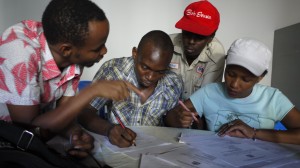
The team of ‘Network’ brainstorm story ideas in Dar es Salaam, Tanzania, 25 June 2012.
 Miracle in Dar es Salaam
Miracle in Dar es Salaam
I’m finally out of Africa and well ensconced now in Paris’ 6th Arrondissement. It’s frankly a welcome change, as I am able at last to recharge my batteries and recover a bit from the sheer exhaustion of the last two months in the trenches of East Africa.
Thinking back over my time in Tanzania and Zanzibar the stories and ideas that are bounding around in my students’ heads never cease to amaze me. One of my students, a modern young Tanzanian woman, reserved and outwardly modest at least, runs her own consulting company in the Tanzanian capital. But put a camera in Suma’s hands and give her several hours of training and you better watch out. She’ll produce a nifty wild-eyed little short film called MONEY HONEYS about two wannabe prostitutes, one from the city, the other from the country, coming to literal fisticuffs in the dirty dusty streets of DSM.
Then there was the quiet guy who works for the famed talk show host Hamza Kosongo at a TV station downtown. For sure I didn’t expect much from Kim. After all I had seen first hand and even participated some rather dreadful local TV programming. But then wow. Kim goes to work and in little more than an hour shooting time produces a veritable comic tour de force beautifully conceived and executed, replete with his own troupe of enormously talented comic actors.
And then there was the young Irish kid, an ex-pat living in this strange and distant country, looking perhaps to find his way in the cinema, and entirely unsure of his abilities as a storyteller. Yannick’s skills needed some direction and discipline but with a little focus they litterally exploded across the screen in his short film A New Pair of Shoes. I love offering my workshops in distant and remote places for this very reason: the surprises that emerge at every turn and twist in the road enthrall and enchant me.
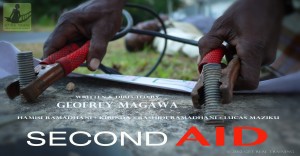
Second Aid by Kim aka Geofrey S. Magawa
 Money Honeys by Ngasuma Kanyeka
Money Honeys by Ngasuma Kanyeka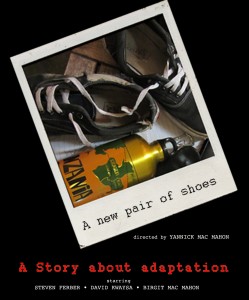
- A New Pair of Shoes by Yannick Mac Mahon
 Illuminating the African Continent
Illuminating the African Continent

- The color, people, and texture, of Zanzibar are unparalleled anywhere else in the world.
This week I am back in Zanzibar at the ZIFF festival leading a one-week camera workshop with local filmmakers. ZIFF is now in its 15th year of hosting mostly African film and music events inside a decaying 17th century fort. It’s a spectacle of spectacles witnessing the local residents in robes and traditional Muslim garb partaking of the offerings in an ancient amphitheatre that once housed legions of pugilistic Omani gladiators.
This is the second year that I’ve had the honor of leading a workshop. In Zanzibar, a mostly conservative Muslim enclave two hours by ferry from the Tanzanian capital, Dar es Salaam, there is little point training in the use of pricey lighting instruments like HMIs and PARs. Instead the required skill is lighting via mirrors and reflectors and white board, delivering high quality light to dark difficult-to-reach interior locations. I became adept at the mirror trick in Uganda several years ago and have since adopted the strategy in all of my work, whether I have a 5-ton lighting and grip truck at my disposal or not.
The point here as it is everywhere else is to work small and fast. Efficiency is the key not only to meeting budget and schedule demands but to inducing the best performance out of the crew and the actors, who hate interrupting their presentation for an hour or more to reset lights for an alternative angle or close up.
In East Africa especially in Tanzania and Zanzibar the filmmakers focus intensely on their stories and the actors who propel them, the casting and performance of these players being front and center of their filmmaking efforts. There is little talk about the relative merits of the RED camera versus Alexa versus C300. What matters here is what ought to REALLY matter to aspiring filmmakers everywhere, and that’s the strength and the compelling nature of their scenarios, and the characters who populate them.
That’s not to say there aren’t serious craft issues here that need addressing. The lack of qualified audio recordists and DOPs undermines the watchability, indeed, the viability of programming in the region. Cameramen need more intensive training in understanding the basic tenets of the cinema, regarding point of view, use of close ups, and the discipline that goes into the every aspect of the craft.
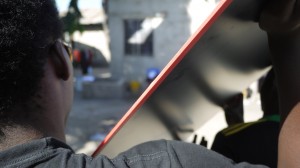
A large mirror measuring a meter square reflects the intense tropical sun into a bedroom on the set of Mdundiko in Dar es Salaam 4 July 2012.
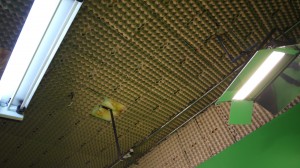
For sound insulation this TV studio in Dar es Salaam utilizes discarded egg cartons in place of expensive acoustic tile.
 Storytelling Prowess in Dar es Salaam
Storytelling Prowess in Dar es Salaam
My current two-week preproduciton workshop in Tanzania is revealing a tremendous amount of latent talent about to emerge in this rapidly growing East African country. My sessions sponsored by Swahiliwood MFDI were not mere trivialities but honest to goodness mini-productions, captured with minimal lighting and equipment, but packing a huge emotional and storytelling punch. In particular I wish to cite director John Kallage, young and extraordinarily gifted, and though lacking formal training, has nevertheless amassed a formidable arsenal of camera and directing skills. He is perhaps THE most talented young filmmaker I have EVER encountered in my workshops conducted around the world.
The chase scene is a staple of my camera and storytelling workshops. Indeed I have assigned such an exercise inclusive of a detailed shot list to my classes in over 20 countries. This sequence by John Kallage in Dar es Salaam this week is one of the best. It was captured in a mere 30 minutes, and that includes the time it took to conceive and storyboard the approximate half-dozen scenes.
 Failing Media Education in the West: What’s Wrong With This Picture
Failing Media Education in the West: What’s Wrong With This Picture
This week I’m in Singapore at Broadcast Asia where I’m presenting a series of mini camera workshops from the Panasonic booth on the expo floor. It is obvious to everyone that South Asia and Southeast Asia have emerged as the new epicenters of technology implementation and future growth. It is just as clear based on my professional work and recent workshops in Asia and Africa that the quality of media education in the United States is failing and that professional opportunities in general in the U.S. and Western Europe will continue to diminish in the next decade. It could be simply due to the current economic malaise in Western countries, but I believe it is due to something else, something more insidious.
About six months ago I was invited to conduct a workshop at a prestigious university outside of Paris. My invitation had to apparently clear a number of daunting obstacles including requisite permissions from the dueling teachers unions that are currently wreaking havoc in universities across the country. Ultimately my invitation was denied due to my insufficient qualifications, most notably my ongoing lack of a PhD. It’s bizarre that with thirty-five years of experience on high profile feature films and documentaries, three books, extensive teaching experience in camera training workshops around the world that a PhD from an insolated acadamic institution should rule the roost.
In America a near-comparable level of bullshit applies as academics and their allies conspire to deny their students the media skills they so desperately need. No such restrictions exist however for film and TV schools and universities across Asia.
Here the demand for proficiency and storytelling skills in the media trumps all other considerations. In Bangladesh five new Dhaka TV stations are coming on line in 2012, and station managers are lamenting the lack of sufficiently skilled workers to fill the exploding number of jobs. These days from Bangladesh to Sri Lanka I can assure you no one is asking a PhD from skilled film and TV professionals willing and eager to share their expertise with students and others aspiring to join the burgeoning media workforce.
Perhaps economic desperation in Europe will help motivate the necessary changes in education and the teaching of media crafts. Any way you look at it the the current state of media education in the West is not a pretty scene to behold.
